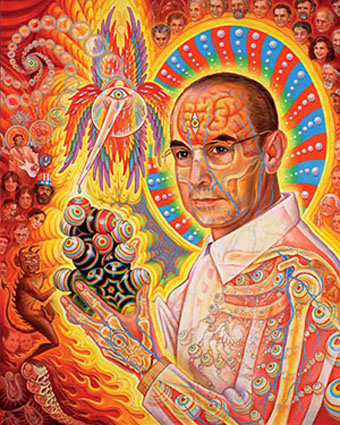This week we discussed neuroscience's role in art. I expected this lecture to be primarily based on how drugs have influenced art throughout history. It is well known that some artists have indulged in drug usage (Erowid). As we learned in part 3 of the lectures, drugs can have an impact on our perception of the world, which I imagine can inspire new forms of art. In fact there has even been research which has studied the links between artists and drugs (Wolf). Below is an example of an artwork influenced by an LSD trip.
LSD, for example, can affect how we perceive colors and shapes (Chapter 4). A famous example of an artists whose drugs may have affected his art is Van Gogh. His drugs have been attributed to many of the artistic characteristics in his portraits and drawings (Van Gogh Gallery).
However, there was a lot more to these lectures. This lead to me questioning my previous definition of art. Before I always maintained that art had to have a message. The message could be something simple or extremely complex and profound, but it had to have a message. The first part of this lecture forced me to think about art's definition again and I am now unsure of what constitutes art.


Above are two examples of what Prof. Vesna defined as art. On the left, we have a drawing of Purkinje Cells by Ramon. On the right, we have an example of a "Brainbow". What is the message of these art works so that I could consider it art? If this is considered art, then where does art stop? When does an image cross the threshold into art? Where do movements stop and dance begins? Is art's definition changing before our very eyes?
Another idea had to do with the potential of neuroscience on art. This idea came while watching lecture 3. As I mentioned above, drugs have the ability to change how we perceive things. In a future time, when we gain a greater understanding of the brain and what separates artistic individuals from non-artistic individuals, it is possible to use drugs to stimulate those areas. Drugs can be made to access any part of the brain (Radford). If this is the case, then it is very possible that in this future, artists while no longer be unique. Everyone would be the same. I believe what makes artists unique is their ability to perceive things differently than the average person. If everyone can use a drug to help stimulate the parts of the brain that once made artists unique, would this be the end of art as we know it?
Sources
"Famous People and Their
Drug Use." The Vaults of Erowid. Erowid.org, 4 Apr. 2012. Web. 18 Nov. 2013.
Wolf, Paul L. "The effects of diseases, drugs, and
chemicals on the creativity and productivity of famous sculptors, classic
painters, classic music composers, and authors." Archives
of pathology & laboratory medicine 129.11 (2005): 1457-1464.
"CHAPTER 4: Perception
Distorting Drugs." Legal
Profession Assistance Conference of the Canadian Bar Association. The Canadian Bar Association, n.d. Web. 18 Nov.
2013.
"Van Gogh's Mental and
Physical Health." Vincent Van Gogh
Gallery. Van Gogh Gallery, n.d. Web. 18 Nov. 2013.
Radford, Benjamin.
"'Limitless' Brain Potential? Humans Already Use Most of Their Brains."LiveScience.
TechMedia Network, 16 Mar. 2011. Web. 18 Nov. 2013.




I think one misstep here is the assumption that art has to have a message. People can derive a "message" from anything. Even if an artist creates something without a specific message in place, some onlooker may see that piece and gain something from it. And so that can't be a requirement for art because it is fulfilled by anything and everything in this world. However that just takes us to the same questions that you reached. Is everything art then? Where are the boundaries? Who knows...I just know that such philosophical questions make me think I need some drugs of my own because they blow my mind.
ReplyDelete